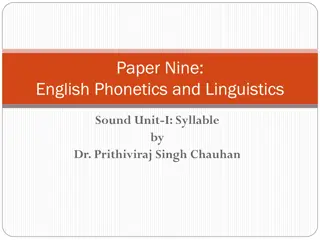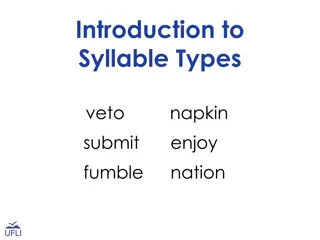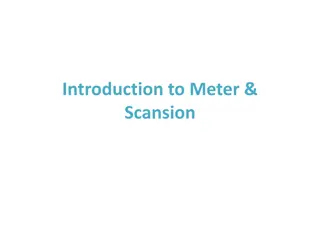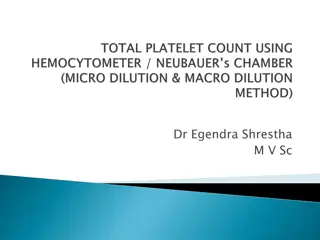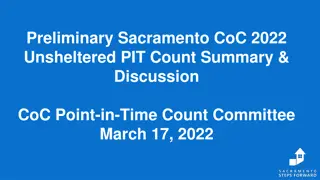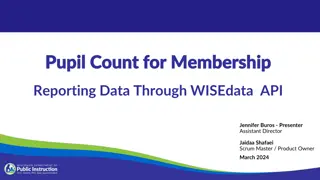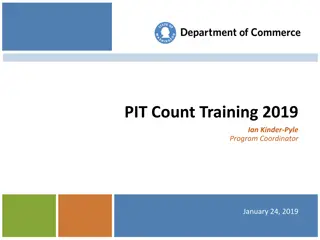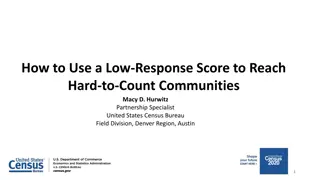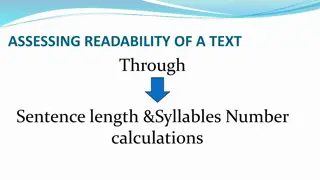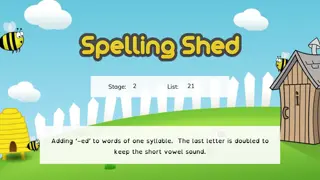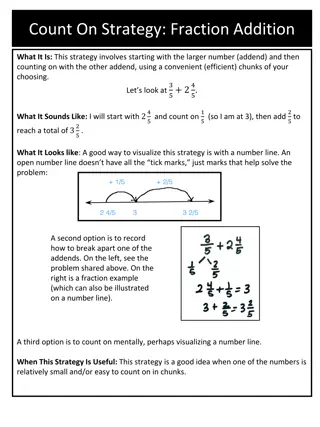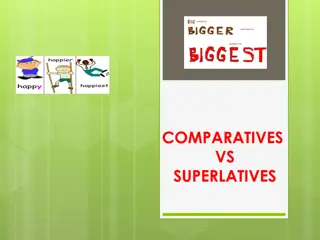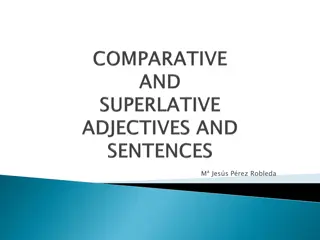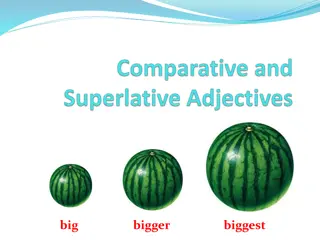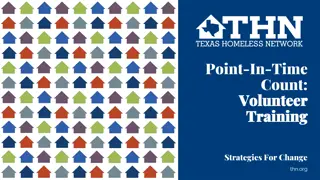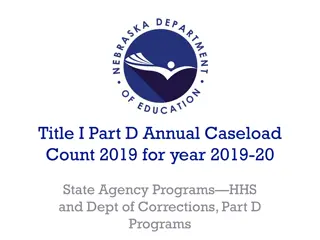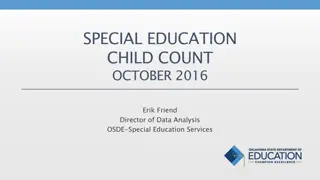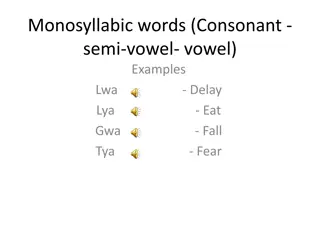Differential white blood cell count
Differential white blood cell count, also known as a leukocyte count, is a crucial test to determine the different types of white blood cells present in the blood. The cells are classified into granulocytes (neutrophils, eosinophils, basophils) and agranulocytes (lymphocytes, monocytes). Blood smear
3 views • 21 slides
Understanding English Syllables: Phonetics and Linguistics Insights
Explore the concept of syllables in English phonetics and linguistics, learning about syllable formation, examples of mono and disyllabic words, and the role of vowels and consonants in syllable structure. Delve into the essence of syllables as individual sound units within words. Discover more thro
11 views • 8 slides
Understanding Red Blood Cell (RBC) Count and Its Significance in Blood Health
Red blood cells, comprising nearly 45% of blood volume, play a crucial role in oxygen transport. The red blood cell count, measured as the number of cells per unit volume of blood, helps assess the adequacy of oxygen-carrying capacity. Normal values vary by age and gender. The experiment aims to det
8 views • 16 slides
Introduction to Syllable Types
Delve into the world of phonetics with this informative content explaining vowel sounds, consonant sounds, and the concept of syllables. Discover the differences between short and long vowel sounds, voiced and unvoiced consonants, and how syllable types can aid in pronunciation. Engage in interactiv
2 views • 31 slides
Understanding WBC Differential Count in Blood Analysis
WBC (white blood cell) count is essential in assessing a patient's health. A differential count helps determine the percentage of different types of white blood cells. This analysis can provide important insights into various health conditions like infections, allergies, and systemic illnesses. The
1 views • 9 slides
Understanding Dactylic Hexameter in Latin Poetry
Latin poetry employs a rhythmic structure known as meter to enhance meaning and poetic effect. Particularly, dactylic hexameter is a prevalent meter in ancient epic poetry, consisting of six feet predominantly made up of dactyls—a long syllable followed by two short syllables. Scanning dactylic he
0 views • 9 slides
Methods for Determination of Microbial Growth
Quantitative determination of microbial growth is crucial for various purposes, with two commonly used methods being the standard plate count and spectrophotometric measurement. The standard plate count method estimates living microbial cell density, while spectrophotometric measurement relies on tu
2 views • 6 slides
Understanding White Blood Cell Count and Measurement Methods
White blood cell count measures the number of white blood cells in a specific volume of blood, indicating infection or disease progression. The normal range is 5000-11000 cells/cubic mm, varying with age. Methods include manual and electronic counting using specific instruments. Materials like antic
0 views • 14 slides
Understanding Platelet Count and its Importance in Blood Clotting
Platelets, also known as thrombocytes, play a crucial role in blood clotting. This article explains the structure and lifespan of platelets, the purpose of performing a total platelet count, and the principle of counting platelets using a hemocytometer. It also describes the components used for plat
0 views • 20 slides
Understanding Syllable Structure and Stress in Phonetics and Phonology
Explore the concepts of syllable structure and stress in phonetics and phonology through examples like analyzing the number of syllables, phonemes, and stress patterns in words. Dive into syllable boundaries, onsets, nuclei, and rhymes in words and phrases to deepen your understanding of English pho
0 views • 35 slides
Understanding Red Blood Cell Count Methods
Explore the principles, normal ranges, and conditions related to red blood cell count. Learn about the apparatus and materials needed for RBC counting, as well as the procedure involved. Understand how changes in RBC count can indicate various health conditions like polycythemia and anemia.
0 views • 27 slides
Mastering 1-Syllable Slender Verbs in Irish Past Tense
Learn the rules for forming the past tense of 1-syllable slender verbs in Irish, including adding a s.imhi (h) after the first letter, using Ar to ask questions, and N or to form negatives. Practice with examples and easy-to-follow instructions for each verb type.
0 views • 6 slides
Estimation of Dead-Time Loss for Neutron Count-Rates
This study discusses the estimation of dead-time loss for high neutron count-rates and the associated multiplicity correction using multi-channel list-mode data. The numerical method for high count-rate dead-time correction in neutron multiplicity counting is described, focusing on the use of multi-
0 views • 6 slides
Point-in-Time Count of Unsheltered Persons Experiencing Homelessness - Volunteer Training Overview
Point-in-Time Count (PIT) is crucial for understanding and addressing homelessness. This volunteer training provides insights into counting unsheltered individuals, gathering demographic data, and why PIT counts are conducted. It emphasizes the importance of measuring trends, strategizing resource a
1 views • 40 slides
Sacramento CoC 2022 Unsheltered PIT Count Summary & Updates
Examining the preliminary findings of the 2022 Sacramento CoC Unsheltered Point-in-Time (PIT) count, this report discusses volunteer efforts, areas covered, and involvement of professional outreach partners. The document outlines future steps, including surveys, data analysis, and planning for the n
0 views • 12 slides
Understanding Interconnect Topology Design and Performance Metrics
Interconnect topology design plays a crucial role in determining the cost and performance of a network. Factors such as the number of switches and links, switch port count, network layout, throughput, packet latency, average hop counts, nodal degree, hop count, and diameter are essential considerati
0 views • 38 slides
Comprehensive Overview of Pupil Count Reporting in WISEdata API
This presentation covers the reporting requirements for pupil count membership data through the WISEdata API, including agenda details, an extended timeline, reasons for the pilot project, and insights into how the Pupil Count Module in WiSFiP works. It also discusses the reporting needs for 2024, t
3 views • 31 slides
Understanding PIT Count Training for Homeless Population
This content provides insights into the PIT Count Training 2019 aimed at understanding and addressing homelessness. It covers topics such as unsheltered and sheltered counts, individuals included and excluded in the PIT count, and strategies to address subpopulations. Additionally, it clarifies what
2 views • 18 slides
Strategies for Reaching Hard-to-Count Communities Using Low-Response Score
Explore how to leverage a low-response score to engage with hard-to-count communities effectively. Learn about ROAM mapping tool, the 2020 Census goal, and the significance of Low Response Score (LRS) in identifying areas for targeted outreach. Discover hard-to-count variables and how to utilize dat
0 views • 14 slides
Understanding Text Readability Through Sentence Length and Syllable Calculations
Analyzing text readability involves calculations such as sentence length and syllable count to determine the grade level of a text. Methods like the Gunning FOG Readability Test utilize formulas or graphs to provide numerical values representing the text's complexity, which can be converted to readi
0 views • 34 slides
Mastering -ed Suffix in One-Syllable Words
Learn how to add the -ed suffix to one-syllable words by doubling the last letter to maintain the short vowel sound. Engage in activities to practice spelling words like patted, hummed, and clapped. Enhance your skills through exercises and unscrambling tasks. Perfect your understanding of this spel
0 views • 8 slides
Efficient Strategies for Fraction and Decimal Addition and Subtraction
Utilize the Count On and Count Back strategies to simplify fraction and decimal addition and subtraction. Start with the larger number and count on with the other addend or break apart the subtrahend into manageable chunks. These visual and mental approaches enhance calculation efficiency and accura
0 views • 4 slides
Mastering Past Tense in Irish Grammar: 2-Syllable Broad Verbs
Understand the rules for forming the past tense with 2-syllable broad verbs in the Irish language, from identifying broad and slender verbs to asking questions and forming negative statements. Learn step-by-step processes and useful tips to enhance your grasp of the past tense.
0 views • 5 slides
Understanding the Comparison of Adjectives and Their Forms
Learn how to form comparatives and superlatives of short and long adjectives, including one-syllable, two-syllable, and irregular adjectives. Discover the rules for adding endings like -er, -est, more, and most, along with examples and comparison structures using "than". Master the correct spelling
0 views • 11 slides
Understanding the 2022 Point-in-Time (PIT) Count of Persons Experiencing Homelessness
Learn about the significance of the annual Point-in-Time Count (PIT) conducted to measure homelessness trends, the distinction between sheltered and unsheltered counts, the guiding principles of the count, its purpose, and the specific locations where unsheltered individuals may be found. Explore wh
0 views • 44 slides
Understanding Iambic Pentameter: Shakespeare's Versification
Iambic Pentameter is a verse rhythm popular in Shakespearean works, featuring 10 syllables per line with alternating stressed and unstressed beats. It distinguishes high-class characters from lower-class ones and allows for creative variations by changing stress patterns and adding syllables. An Iam
0 views • 47 slides
Understanding Comparatives and Superlatives in Adjectives
Learn about comparatives and superlatives in adjectives, including examples of short and long adjectives, as well as irregular forms. Discover how to form comparative and superlative adjectives with one-syllable and multi-syllable words. Gain insights into common irregular adjectives like good, bad,
0 views • 7 slides
Rules for Forming Comparative and Superlative Adjectives
Learn the rules for forming comparatives and superlatives of adjectives based on syllable count and endings. Understand the spelling conventions and exceptions for one, two, and three-syllable adjectives, as well as irregular adjectives. Master the comparative and superlative forms to enhance your E
0 views • 11 slides
Understanding Adjective Comparison in English Grammar
Explore the rules for forming comparative and superlative forms of adjectives in English grammar. Learn about irregular comparisons, one-syllable adjectives, adjectives ending in -y, -ow, -le, -er, multi-syllable adjectives, hyphenated adjectives, and more. Discover the nuances of adjectives with on
0 views • 14 slides
Comparatives and Superlatives of Adjectives: Rules and Examples
Learn how to form comparative and superlative forms of one-syllable and two-syllable adjectives, including rules for adding suffixes, doubling consonants, ending with "y", and irregular adjectives. Examples and images included for easy understanding.
0 views • 7 slides
Point-In-Time Count Strategies for Homelessness Assistance
Snapshot of homeless individuals in a community on a single day to plan services, measure progress, and identify needs, strengths, and gaps. Process involves selecting a PIT lead, forming a committee, training volunteers, and counting individuals in various settings. Differentiates between who to co
0 views • 32 slides
Buckinghamshire Claimant Count Analysis March 2023
This report provides insights into the Claimant Count and Alternative Claimant Count in Buckinghamshire for March 2023. The data reveals an increase in the number of residents claiming out-of-work related benefits compared to previous months, with detailed breakdowns by parliamentary constituencies.
0 views • 15 slides
Buckinghamshire's Claimant Count Analysis February 2021
This report provides a detailed analysis of Buckinghamshire's Claimant Count and Alternative Claimant Count for February 2021, based on data from the Department for Work and Pensions. It includes insights on claimant trends, rates, and comparisons to national and other regional statistics.
0 views • 17 slides
Canon Oc Copier Copy and Scan Count Instructions
Follow these steps to enter the copy and scan counts for your new Canon Oc copier. Start by entering the copier serial number, then press the Counter Check button to view the current copy count. Next, check the Scan Count by totaling the black and white scans with color scans. Use the provided image
0 views • 6 slides
Summary of Buckinghamshire's Out-of-Work Benefits Claimant Count
This report provides a summary of the number of Buckinghamshire residents claiming out-of-work related benefits (the Claimant Count). In July 2024, 10,520 Buckinghamshire residents were claiming these benefits, reflecting an increase from the period before the Covid-19 pandemic. The Claimant Count r
0 views • 11 slides
State Agency Annual Caseload Count Process for Title I Part D Programs
State agencies participate in an annual caseload count process for Title I Part D programs to determine funding allocations. The process involves a one-day count of students in HHS and Dept. of Corrections programs, with specific guidelines for data collection and reporting.
0 views • 9 slides
Buckinghamshire's Out-of-Work Benefits Claimant Count January 2023 Report
This report provides a monthly summary of Buckinghamshire residents claiming out-of-work related benefits, detailing the Claimant Count and Alternative Claimant Count for December 2022. It includes statistical data analysis, trends, and comparisons to national averages, offering insights into the im
0 views • 15 slides
Overview of Special Education Child Count October 2016
Introduction to the Special Education Child Count process conducted annually in October, collecting data for state and federal reporting purposes, impacting funding allocations based on the count. The data review process, including checks for ensuring quality data, eligibility documentation, IEP fin
0 views • 12 slides
Exploring Monosyllabic and Polysyllabic Words in Luganda
Discover the structure of monosyllabic words in Luganda consisting of consonant-semi-vowel-vowel patterns like Lwa and Gwa, as well as those with consonant-consonant-semi-vowel-vowel patterns like Mbwa and Nswa. Further explore the realm of polysyllabic words in Luganda, where each syllable ends wit
0 views • 4 slides
Understanding Complete Blood Count (CBC) Testing
Complete Blood Count (CBC) is a crucial test that provides information about the composition of a patient's blood, including red blood cells, white blood cells, and platelets. This test helps in diagnosing conditions such as anemia, infections, and more. CBC involves analyzing parameters like RBC co
0 views • 20 slides

